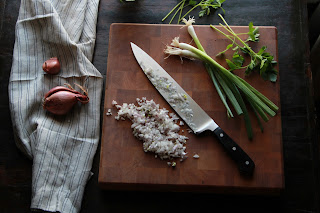I love crêpes, and this particular version was initially a bit experimental, partially meant as a way to help use up buttermilk.
Am I the only one who buys a quart- since most of the time that's all I can find- only to use 1/2 cup or so? I'm thinking not...The rest was using some of the things on hand.
Buckwheat, one thing I have but not something that I happen to use religiously, is somewhat earthy and a crêpe (galette) classic.
Oat flour (a favorite flour of mine, actually) add slightly sweet nuttiness.
The overall flavor seems especially nice when paired with strawberries
The results aren't bad at all, I think, so here you go.
(And basically, yes, it has so far assisted in reducing buttermilk supply, and will continue to do so when I have an excess of buttermilk. Then again, maybe I'll be purchasing buttermilk solely for this purpose.)
Crêpes are initially delicate while they're cooking- so a well seasoned pan is paramount.
And a steel crêpe pan is certainly nice, but not entirely necessary.
Note for a crêpe pan: don't let anyone scrub the finish (seasoning) off your pan that you worked to put there in the first place- it's what keeps the pan nonstick and is so much more convenient than dealing with the alternative.
And remember, the first crêpe or two can often be duds. No big deal. They're still edible.
My favorite is eating the crêpes right off the heat, "failed" and torn or not, tender with crispy edges.
Folded with fresh berries and topped with whipped cream is always a good option, rolled into cigars with a bit of cinnamon sugar or a very thin layer of jam, chocolate, or lemon curd is another possibility.
The sliced banana and Nutella combination is pretty classic, too.
Crêpes Suzette is a bit more involved than the more basic crêpe I'm offering today, but also very nice.
A high-stacked crêpe cake layered with chocolate or a cream between crêpes would also be an idea.
OR, maybe omit the sugar, add a pinch more salt, and fill with cheese, sauteed mushrooms (or maybe this version instead), ham, eggs, ham and eggs... or whatever other savory things you might like.
Oat and Buckwheat Crêpes
(makes 15-20, 6 inch crepes)
1/2 c (55 g) oat flour
3/4 c (115 g) buckwheat flour
1/4 t (2 g) salt
1 T (16 g) sugar
3 large eggs
2 T (30 g) butter, melted
1/2 c (125 ml) buttermilk
3/4 c (180 ml) whole milk
1/2 c (125 ml) water, plus extra as necessary
Butter, to cook the crepes
In a medium bowl, whisk together the flours, salt, and sugar until well blended. Add the eggs and butter, and whisk, breaking up any lumps, until a smooth paste forms. Add the buttermilk and whisk the mixture together until incorporated. Finish by adding the milk and water into the mixture, and carefully blend to a nice pour-able batter.
Cover and refrigerate to rest and let the flours absorb the liquid at least an hour and up to a day.
When ready to cook the crêpes, remove the batter from the fridge and place a well-seasoned pan over medium heat to warm.
While the pan heats, check the consistency of your batter, stir and then pour a bit back into the bowl. You want it to be about like a nice heavy cream- NOT glue. Add water, maybe 1 T (15 ml) at a time or so until you reach the correct consistency.
To the now-hot pan, add a bit of butter. After the butter melts and foams, swirl the pan to coat the bottom with a thin layer.
Remove the pan from the heat with your non-dominant hand and pour batter into the pan using your dominant hand, aiming for somewhere between 3 T and 1/4 c range (45-60 ml). Quickly swirl the pan to evenly distribute the batter. Place the pan back on the heat and cook a couple minutes. The top of the crêpe will appear more matte and tacky, while the edges will crisp a little and possibly pull away from the sides. Carefully slide a rubber spatula around the edge and under the center, pick the crêpe up off the pan, and flip it so the cooked side is up. Cook a further minute or two until the second side is slightly browned and the crêpe slides around on the pan easily.
(If you've found that the batter is a bit thick and doesn't flow and "swirl" properly, you'll likely need to thin the batter with a bit of water- or potentially add a bit more flour if it's too thin so it behaves appropriately.)
Slide the crêpe out of the pan and onto a plate, stack the crêpes as you go, or serving them as they are made.
Continue in the same manner to cook the remaining crêpe batter, adding a little butter to the pan, etc., and stirring the batter a bit between crêpes to make sure the batter remains fairly uniform throughout.
Serve as desired.
NOTE/UPDATE:
I've found they work out quite well lactose-free too, if replacing both the milk and buttermilk measurements with an alternative milk. I've used unsweetened "milk" made with peas (Ripple) and had great results. Ghee can replace the melted butter- I've not tried other oils, but at some point I'd try coconut oil to make the crêpes completely dairy-free.
















